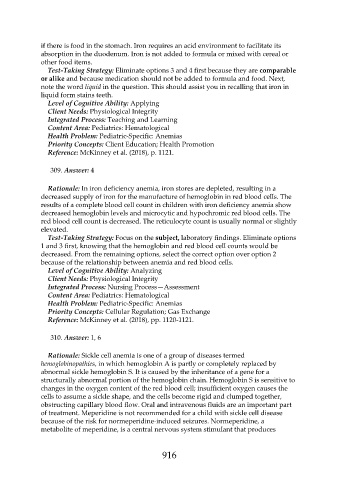Page 916 - Saunders Comprehensive Review For NCLEX-RN
P. 916
if there is food in the stomach. Iron requires an acid environment to facilitate its
absorption in the duodenum. Iron is not added to formula or mixed with cereal or
other food items.
Test-Taking Strategy: Eliminate options 3 and 4 first because they are comparable
or alike and because medication should not be added to formula and food. Next,
note the word liquid in the question. This should assist you in recalling that iron in
liquid form stains teeth.
Level of Cognitive Ability: Applying
Client Needs: Physiological Integrity
Integrated Process: Teaching and Learning
Content Area: Pediatrics: Hematological
Health Problem: Pediatric-Specific: Anemias
Priority Concepts: Client Education; Health Promotion
Reference: McKinney et al. (2018), p. 1121.
309. Answer: 4
Rationale: In iron deficiency anemia, iron stores are depleted, resulting in a
decreased supply of iron for the manufacture of hemoglobin in red blood cells. The
results of a complete blood cell count in children with iron deficiency anemia show
decreased hemoglobin levels and microcytic and hypochromic red blood cells. The
red blood cell count is decreased. The reticulocyte count is usually normal or slightly
elevated.
Test-Taking Strategy: Focus on the subject, laboratory findings. Eliminate options
1 and 3 first, knowing that the hemoglobin and red blood cell counts would be
decreased. From the remaining options, select the correct option over option 2
because of the relationship between anemia and red blood cells.
Level of Cognitive Ability: Analyzing
Client Needs: Physiological Integrity
Integrated Process: Nursing Process—Assessment
Content Area: Pediatrics: Hematological
Health Problem: Pediatric-Specific: Anemias
Priority Concepts: Cellular Regulation; Gas Exchange
Reference: McKinney et al. (2018), pp. 1120-1121.
310. Answer: 1, 6
Rationale: Sickle cell anemia is one of a group of diseases termed
hemoglobinopathies, in which hemoglobin A is partly or completely replaced by
abnormal sickle hemoglobin S. It is caused by the inheritance of a gene for a
structurally abnormal portion of the hemoglobin chain. Hemoglobin S is sensitive to
changes in the oxygen content of the red blood cell; insufficient oxygen causes the
cells to assume a sickle shape, and the cells become rigid and clumped together,
obstructing capillary blood flow. Oral and intravenous fluids are an important part
of treatment. Meperidine is not recommended for a child with sickle cell disease
because of the risk for normeperidine-induced seizures. Normeperidine, a
metabolite of meperidine, is a central nervous system stimulant that produces
916

